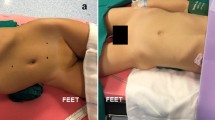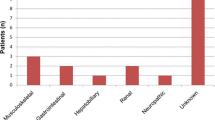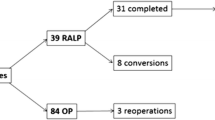Abstract
Purpose
This multicentric study aimed to report our experience with robot-assisted laparoscopic pyeloplasty (RALP) in children with horseshoe kidney (HSK).
Methods
The records of 14 patients (11 boys and 3 girls with an average age of 9 years), who underwent RALP for repair of pelvi–ureteric junction obstruction (PUJO) in HSK in five international pediatric urology units over a 5-year period, were retrospectively reviewed. A dismembered pyeloplasty with no division of isthmus was performed in all the cases.
Results
The average operative time including docking was 143.5 min (range 100–205). No conversions to laparoscopy or open surgery or intra-operative complications occurred. Patients were discharged on postoperative day 2 following catheter and drain removal. The JJ stent was removed at mean 33 days postoperatively. Overall success rate was 92.8%. As for postoperative complications, we recorded a urinary tract infection (UTI) and stent-related irritative symptoms, managed with medical therapy, in two patients (II Clavien) and an anastomotic stricture in one patient needing surgical revision with no further recurrence (IIIb Clavien). At follow-up, all the patients (one after redo-surgery) reported complete resolution of symptoms, improvement of hydronephrosis on ultrasound and no residual obstruction on diuretic renogram.
Conclusions
Our experience suggested that RALP in HSK is safe, feasible and with good medium-term outcomes in expert hands. An accurate pre-operative planning associated with a standardized technique is key points to achieve good surgical and functional outcomes in these challenging cases. The da Vinci robot technology offers the advantages of MIS procedures and overcomes the technical challenges of laparoscopic approach.




Similar content being viewed by others
References
Natsis K, Piagkou M, Skotsimara A, Protogerou V, Tsitouridis I, Skandalakis P (2014) Horseshoe kidney: a review of anatomy and pathology. Surg Radiol Anat 36(6):517–526
Nishi M, Iwamura M, Kurosaka S, Fujita T, Matsumoto K, Yoshida K (2013) Laparoscopic Anderson–Hynes pyeloplasty without symphysiotomy for hydronephrosis with horseshoe kidney. Asian J Endosc Surg 6(3):192–196
Yohannes P, Smith AD (2002) The endourological management of complications associated with horseshoe kidney. J Urol 168(1):5–8
Faddegon S, Granberg C, Tan YK, Gargollo PC, Cadeddu JA (2013) Minimally invasive pyeloplasty in horseshoe kidneys with ureteropelvic junction obstruction: a case series. Int Braz J Urol 39(2):195–202
Lallas CD, Pak RW, Pagnani C, Hubosky SG, Yanke BV, Keeley FX, Bagley DH (2011) The minimally invasive management of ureteropelvic junction obstruction in horseshoe kidneys. World J Urol 29(1):91–95
Spencer CD, Sairam K, Challacombe B, Murphy D, Dasgupta P (2009) Robot-assisted laparoscopic pyeloplasty for the management of pelvi–ureteric junction obstruction in horseshoe kidneys: initial experience. J Robot Surg 3:99–102
O’Reilly PH, Brooman PJ, Mak S, Jones M, Pickup C, Atkinson C, Pollard AJ (2001) The long-term results of Anderson–Hynes pyeloplasty. BJU Int 87(4):287–289
Cascio S, Tien A, Chee W, Tan HL (2007) Laparoscopic dismembered pyeloplasty in children younger than 2 years. J Urol 177(1):335–338
Lopez M, Guye E, Varlet F (2009) Laparoscopic pyeloplasty for repair of pelvi–ureteric junction obstruction in children. J Pediatr Urol 5(1):25–29
Blanc T, Koulouris E, Botto N, Paye-Jaouen A, El-Ghoneimi A (2014) Laparoscopic pyeloplasty in children with horseshoe kidney. J Urol 191(4):1097–1103
Kawauchi A, Fujito A, Yoneda K, Soh J, Naitoh Y, Mizutani Y, Miki T (2005) Laparoscopic pyeloplasty and isthmectomy for hydronephrosis of horseshoe kidney: a pediatric case. J Endourol 19(8):984–986
Boysen WR, Gundeti MS (2017) Robot-assisted laparoscopic pyeloplasty in the pediatric population: a review of technique, outcomes, complications, and special considerations in infants. Pediatr Surg Int 33:925–935
Oderda M, Calleris G, Allasia M, Dalmasso E, Falcone M, Catti M, Merlini E, Gontero P (2017) Robot-assisted laparoscopic pyeloplasty in a pediatric patient with horseshoe kidney: surgical technique and review of the literature. Urologia 84(1):55–60
Chammas M Jr, Feuillu B, Coissard A, Hubert J (2006) Laparoscopic robotic-assisted management of pelvi–ureteric junction obstruction in patients with horseshoe kidneys: technique and 1-year follow-up. BJU Int 97(3):579–583
Pe ML, Sterious SN, Liu JB, Lallas CD (2008) Robotic dismembered pyeloplasty in a horseshoe kidney after failed endopyelotomy. JSLS 12(2):210–212
Schwentner C, Pelzer A, Neururer R, Springer B, Horninger W, Bartsch G, Peschel R (2007) Robotic Anderson–Hynes pyeloplasty: 5-year experience of one centre. BJU Int 100(4):880–885
Dindo D, Demartines N, Clavien PA (2004) Classification of surgical complications. A new proposal with evaluation in a cohort of 6336 patients and results of a survey. Ann Surg 240:205–213
Siqueira TM Jr, Nadu A, KuoRL Paterson RF, Lingeman JE, Shalhav AL (2002) Laparoscopic treatment for ureteropelvic junction obstruction. Urology 60:973–978
Pitts WR Jr, Muecke EC (1975) Horseshoe kidneys: a 40-year experience. J Urol 113:743–746
Das S, Amar AD (1984) Ureteropelvic junction obstruction with associated renal anomalies. J Urol 131:872–874
Khoder WY, Alghamdi A, Schulz T, Becker AJ, Schlenker B, Stief CG (2016) An innovative technique of robotic-assisted/laparoscopic re-pyeloplasty in horseshoe kidney in patients with failed previous pyeloplasty for ureteropelvic junction obstruction. Surg Endosc 30(9):4124–4129
Mostafavi MR, Prasad PV, Saltzman B (1998) Magnetic resonance urography and angiography in the evaluation of a horseshoe kidney with ureteropelvic junction obstruction. Urology 51:484–486
Panda SS, Bajpai M, Jana M, Baidya DK, Kumar R (2014) Anderson–Hynes pyeloplasty with isthmotomy and lateropexy in horseshoe kidneys with pelviureteric junction obstruction in children. Indian J Urol 30:161–163
Potretzke AM, Mohapatra A, Larson JA, Benway BM (2016) Transmesenteric robot-assisted pyeloplasty for ureteropelvic junction obstruction in horseshoe kidney. Int Braz J Urol 42(Video #5):626–627
Culp OS, Winterringer JR (1955) Surgical treatment of horseshoe kidney: comparison of results after various types of operations. J Urol 73:747–756
Schuster T, Dietz HG, Schutz S (1999) Anderson–Hynes pyeloplasty in horseshoe kidney in children: is it effective without symphysiotomy? Pediatr Surg Int 15:230–233
Author information
Authors and Affiliations
Contributions
CE: project development, data collection, manuscript writing, and manuscript editing; LM: data collection, data analysis, and manuscript editing; TB: data collection, data analysis, and manuscript editing; GM: data collection, data analysis, and manuscript editing; SS: data collection, data analysis, and manuscript editing; ME: project development, data analysis, manuscript writing, and manuscript editing.
Corresponding author
Ethics declarations
Conflict of interest
The authors declare that they have no conflict of interest or financial ties to disclose.
Ethical approval
All procedures performed in studies involving human participants were in accordance with the ethical standards of the institutional and/or national research committee and with the 1964 Helsinki Declaration and its later amendments or comparable ethical standards. For this type of study, formal consent is not required.
Research involving human participants and/or animals
This article does not contain any studies with animals performed by any of the authors.
Informed consent
Informed consent was obtained from all individual participants included in the study.
Rights and permissions
About this article
Cite this article
Esposito, C., Masieri, L., Blanc, T. et al. Robot-assisted laparoscopic pyeloplasty (RALP) in children with horseshoe kidneys: results of a multicentric study. World J Urol 37, 2257–2263 (2019). https://doi.org/10.1007/s00345-019-02632-x
Received:
Accepted:
Published:
Issue Date:
DOI: https://doi.org/10.1007/s00345-019-02632-x




